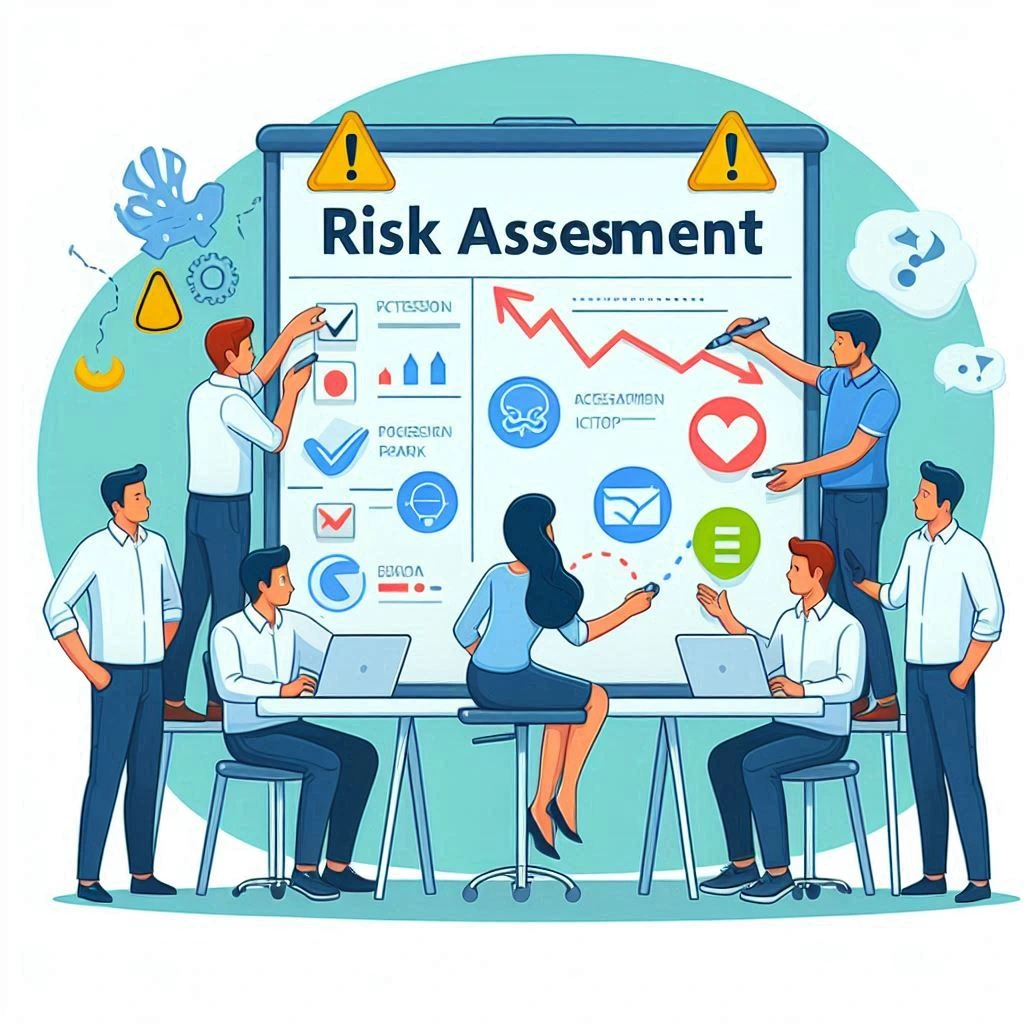Introduction to Operational Risk Assessment
Organizations are increasingly exposed to a variety of operational risks that can impact their performance and sustainability. Understanding and managing these risks is crucial, especially for agile organizations that must adapt quickly to changing circumstances.
Understanding Agile Organizations
Agile organizations have emerged as a vital response to the challenges posed by fast-paced changes and uncertainties. These organizations are characterized by their ability to adapt, innovate, and respond swiftly to market dynamics, making them distinct from traditional, rigid structures. Here are some key aspects that define agile organizations and highlight the necessity for a dynamic operational risk assessment template tailored to their unique needs.
Definition of Agile Organizations
Agile organizations prioritize adaptability, responsiveness, and innovation. They are built to embrace change and foster a culture of continuous improvement, which is essential in a business environment that is constantly shifting due to technological advancements, market demands, and customer expectations. Unlike traditional organizations that often rely on hierarchical structures, agile organizations operate through networks of teams that share a common purpose and vision, allowing for more collaborative and effective decision-making processes [4][13].
Fast-Paced Changes and Uncertainties
Agile organizations face a multitude of challenges, including rapid technological changes, evolving customer preferences, and increased competition. These factors create an environment of uncertainty where traditional risk assessment methods may fall short. For instance, conventional approaches often rely on static frameworks that do not account for the dynamic nature of agile operations. As a result, organizations may struggle to identify and mitigate risks effectively, leading to potential setbacks in their strategic objectives [4][10].
The Need for Flexibility and Adaptability in Risk Management
Given the unique characteristics of agile organizations, there is a pressing need for flexibility and adaptability in risk management practices. Traditional risk assessment methods may not provide the necessary agility to respond to emerging risks promptly. Instead, agile organizations benefit from a proactive approach that emphasizes continuous risk assessment, collaboration, and swift adaptation to changing circumstances. This involves creating a risk assessment template that is not only dynamic but also integrates feedback loops and iterative processes, allowing organizations to stay ahead of potential threats and capitalize on opportunities as they arise [6][7][14].
Key Components of a Dynamic Operational Risk Assessment Template
In the context of internal auditing within agile organizations, a dynamic operational risk assessment template is crucial for effectively managing risks in fast-paced business environments. This template should be designed to be flexible and adaptable, allowing internal auditors to respond swiftly to emerging threats. Here are the essential elements that should be included:
1. Core Components
- Risk Categories: The template should categorize risks into distinct groups, such as operational, financial, compliance, and strategic risks. This categorization helps in identifying specific areas of concern and facilitates targeted assessments. By clearly defining these categories, organizations can streamline their risk management processes and ensure comprehensive coverage of potential threats [9].
- Impact Assessments: Each identified risk should be accompanied by an impact assessment that evaluates the potential consequences of the risk materializing. This assessment should consider factors such as financial loss, reputational damage, and operational disruptions. By quantifying the impact, organizations can prioritize risks and allocate resources effectively to mitigate them [9].
- Mitigation Strategies: The template must outline specific strategies for mitigating identified risks. This includes preventive measures, contingency plans, and response protocols. By having well-defined strategies in place, organizations can enhance their resilience and ensure a swift response to any operational disruptions [9].
2. Continuous Monitoring and Updating
A dynamic operational risk assessment template should incorporate mechanisms for continuous monitoring and updating. In agile environments, risks can evolve rapidly, making it essential to regularly reassess and adjust the template. This involves:
- Real-Time Data Integration: Utilizing real-time data and analytics to monitor risk indicators continuously. This allows organizations to detect potential new risks and weaknesses as they arise, enabling proactive management [12].
- Regular Reviews: Establishing a schedule for periodic reviews of the risk assessment template to ensure it remains relevant and effective. This includes updating risk categories, impact assessments, and mitigation strategies based on the latest information and organizational changes [8].
3. Stakeholder Input
The role of stakeholder input is vital in shaping a dynamic operational risk assessment template. Engaging various stakeholders, including management, employees, and external partners, can provide valuable insights into potential risks and effective mitigation strategies. This collaborative approach ensures that the template reflects a comprehensive understanding of the organization’s risk landscape. Key aspects include:
- Feedback Mechanisms: Implementing channels for stakeholders to provide feedback on the risk assessment process and the effectiveness of current mitigation strategies. This feedback can inform necessary adjustments to the template [9].
- Cross-Functional Collaboration: Encouraging collaboration between different departments to identify risks that may not be immediately apparent. This holistic view can enhance the template’s adaptability and effectiveness in addressing diverse operational challenges [9].
Designing the Template for Flexibility
Internal auditors must develop operational risk assessment templates that are not only effective but also adaptable to the ever-changing landscape of their organizations. A dynamic operational risk assessment template can significantly enhance the agility of internal audit functions, allowing them to respond promptly to emerging risks and opportunities. Here are key considerations for designing such a template:
- Incorporate Iterative Processes and Feedback Loops: A flexible operational risk assessment template should be built on iterative processes that allow for continuous improvement. This means regularly revisiting and refining the template based on feedback from users and stakeholders. By establishing feedback loops, auditors can ensure that the template remains relevant and effective in identifying and assessing risks as the organization evolves. This approach aligns with the need for a systematic method to understand, assess, and prioritize risks, as highlighted in best practices for internal audits [3][7].
- Utilize Technology and Tools for Real-Time Updates and Data Collection: Leveraging modern technology is crucial for creating a responsive operational risk assessment template. Tools that facilitate real-time data collection and analysis can provide auditors with up-to-date insights into the organization’s risk posture. This enables timely decision-making and enhances the overall effectiveness of the risk management process. Organizations that adopt a dynamic risk assessment approach can continuously expose their risk posture to management, rather than relying on periodic assessments [6][12].
- Highlight the Importance of User-Friendly Design for Broader Team Engagement: A well-designed template should prioritize user-friendliness to encourage broader engagement from team members across the organization. When the template is intuitive and easy to navigate, it fosters collaboration and ensures that various stakeholders can contribute to the risk assessment process. This inclusivity not only enriches the data collected but also promotes a culture of risk awareness throughout the organization. A user-friendly design is essential for effective communication of risks and controls, ultimately supporting the organization’s strategic decision-making [9][15].
By focusing on these key points, internal auditors can create a dynamic operational risk assessment template that not only meets the current needs of their agile organizations but also adapts to future challenges and opportunities. This proactive approach will enhance the internal audit function’s ability to safeguard the organization against operational risks while supporting its strategic objectives.
Implementing the Operational Risk Assessment Template
A well-structured operational risk assessment template can significantly enhance an organization’s ability to identify, evaluate, and mitigate risks effectively. Below is a step-by-step approach for rolling out this template within agile organizations.
Stages of Implementation
- Pilot Testing:
- Begin with a pilot program involving a small, representative team. This allows for real-world testing of the template in a controlled environment.
- Gather feedback on usability, clarity, and effectiveness to make necessary adjustments before a broader rollout.
- Refinement:
- Analyze the feedback collected during the pilot phase to refine the template. This may include simplifying language, adding examples, or adjusting the risk categories to better fit the organization’s context.
- Full Rollout:
- Once the template has been refined, implement it across the organization. Ensure that all relevant teams are informed about the new process and understand its significance.
- Schedule a formal launch event to generate excitement and buy-in from all stakeholders.
Training and Support
- Comprehensive Training:
- Develop a training program tailored to different teams that will use the template. This should cover the purpose of the template, how to fill it out, and how to interpret the results.
- Utilize various training methods, such as workshops, webinars, and hands-on sessions, to accommodate different learning styles.
- Ongoing Support:
- Establish a support system for teams as they begin using the template. This could include a dedicated helpdesk, regular check-ins, and access to resources such as FAQs and user guides.
- Encourage teams to share their experiences and best practices, fostering a culture of continuous improvement.
Ongoing Support:
Communicating Value to Stakeholders
- Highlighting Benefits:
- Clearly communicate the value of the operational risk assessment template to stakeholders. Emphasize how it enhances decision-making, improves risk visibility, and supports compliance efforts.
- Use data and case studies to illustrate the positive impact of the template on operational efficiency and risk management.
- Engagement Strategies:
- Involve stakeholders in the implementation process by seeking their input and addressing their concerns. This can help build trust and ensure that the template meets their needs.
- Regularly update stakeholders on the progress and successes achieved through the use of the template, reinforcing its importance and encouraging ongoing engagement.
By following these steps, internal auditors can effectively implement a dynamic operational risk assessment template that not only meets the needs of agile organizations but also enhances their overall risk management capabilities. This proactive approach will ultimately contribute to a more resilient and adaptable organization in the face of evolving challenges.
Maintaining and Updating the Template
In the context of internal auditing, particularly within agile organizations, the operational risk assessment template must be a living document that evolves alongside the business. Regular reviews and updates are crucial to ensure that the template remains relevant and effective in identifying and mitigating risks. Here are some key points to consider:
- Importance of Regular Reviews: Conducting periodic evaluations of the operational risk assessment template is essential. This practice not only helps in identifying outdated information but also ensures that the template aligns with current business processes and risk landscapes. Regular updates can enhance the accuracy of risk assessments and improve decision-making processes within the organization [2][10].
- Triggers for Updates: Several factors can necessitate updates to the operational risk assessment template. Key triggers include:
- Organizational Changes: Mergers, acquisitions, or shifts in business strategy can introduce new risks or alter existing ones. It is vital to reassess the template to reflect these changes accurately [6].
- New Regulatory Requirements: Compliance with evolving regulations is critical. When new laws or guidelines are introduced, the template should be updated to incorporate these requirements, ensuring that the organization remains compliant and minimizes legal risks [4][10].
- Technological Advancements: As technology evolves, so do the risks associated with it. Updates should be made to address new technological risks, such as cybersecurity threats, which may not have been previously considered [5].
- Encouraging a Culture of Continuous Improvement: Fostering an environment that values continuous improvement in risk assessment practices is vital for agile organizations. This can be achieved by:
- Training and Development: Providing ongoing training for internal auditors on the latest risk assessment methodologies and tools can enhance their ability to identify and manage risks effectively [3][8].
- Feedback Mechanisms: Implementing feedback loops where team members can share insights and experiences related to risk assessments can lead to valuable updates and improvements in the template [9].
- Collaboration Across Departments: Encouraging collaboration between different departments can help in identifying risks that may not be apparent within a single function. This holistic approach can lead to a more comprehensive and effective operational risk assessment template [7].
By prioritizing the maintenance and updating of the operational risk assessment template, agile organizations can better navigate the complexities of their fast-paced environments, ensuring that they remain resilient and responsive to emerging risks.
Conclusion
As organizations increasingly adopt agile methodologies, internal auditors must recognize that a static approach to risk management is no longer sufficient. A dynamic operational risk assessment template empowers auditors to respond swiftly to emerging risks and adapt their strategies in real-time, ensuring that risk management remains aligned with organizational objectives and market conditions. By adopting and customizing this template, internal auditors can better address the unique challenges and opportunities presented by their specific organizational contexts. This adaptability not only enhances the effectiveness of risk assessments but also fosters a culture of proactive risk management within the organization.
Find out more about Shaun Stoltz https://www.shaunstoltz.com/about/
This post was written by an AI and reviewed/edited by a human.



